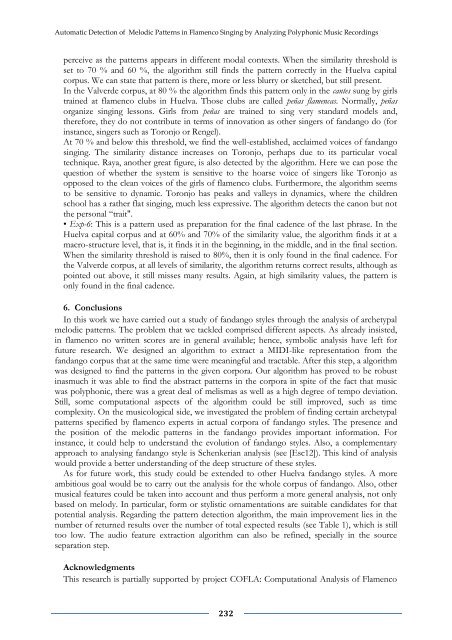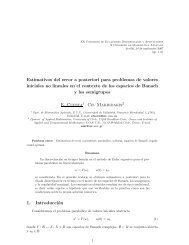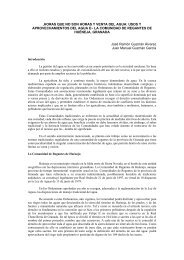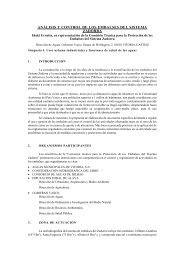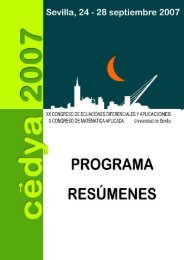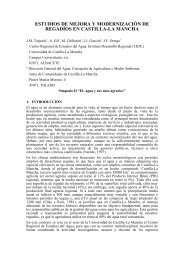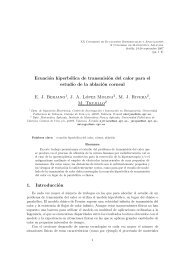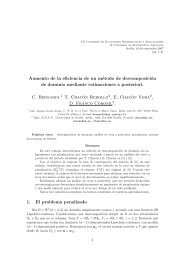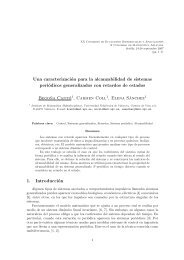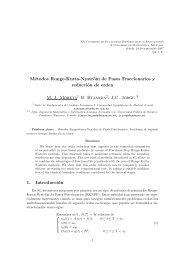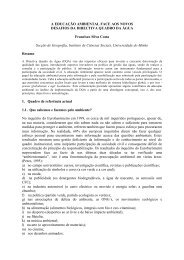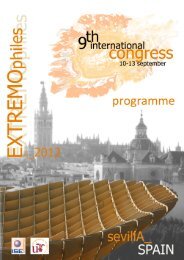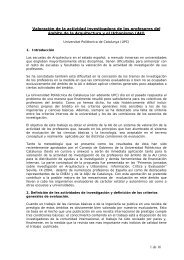LIBRO DE ACTAS (pdf) - Universidad de Sevilla
LIBRO DE ACTAS (pdf) - Universidad de Sevilla
LIBRO DE ACTAS (pdf) - Universidad de Sevilla
You also want an ePaper? Increase the reach of your titles
YUMPU automatically turns print PDFs into web optimized ePapers that Google loves.
Automatic Detection of Melodic Patterns in Flamenco Singing by Analyzing Polyphonic Music Recordings<br />
perceive as the patterns appears in different modal contexts. When the similarity threshold is<br />
set to 70 % and 60 %, the algorithm still finds the pattern correctly in the Huelva capital<br />
corpus. We can state that pattern is there, more or less blurry or sketched, but still present.<br />
In the Valver<strong>de</strong> corpus, at 80 % the algorithm finds this pattern only in the cantes sung by girls<br />
trained at flamenco clubs in Huelva. Those clubs are called peñas flamencas. Normally, peñas<br />
organize singing lessons. Girls from peñas are trained to sing very standard mo<strong>de</strong>ls and,<br />
therefore, they do not contribute in terms of innovation as other singers of fandango do (for<br />
instance, singers such as Toronjo or Rengel).<br />
At 70 % and below this threshold, we find the well-established, acclaimed voices of fandango<br />
singing. The similarity distance increases on Toronjo, perhaps due to its particular vocal<br />
technique. Raya, another great figure, is also <strong>de</strong>tected by the algorithm. Here we can pose the<br />
question of whether the system is sensitive to the hoarse voice of singers like Toronjo as<br />
opposed to the clean voices of the girls of flamenco clubs. Furthermore, the algorithm seems<br />
to be sensitive to dynamic. Toronjo has peaks and valleys in dynamics, where the children<br />
school has a rather flat singing, much less expressive. The algorithm <strong>de</strong>tects the canon but not<br />
the personal “trait".<br />
• Exp-6: This is a pattern used as preparation for the final ca<strong>de</strong>nce of the last phrase. In the<br />
Huelva capital corpus and at 60% and 70% of the similarity value, the algorithm finds it at a<br />
macro-structure level, that is, it finds it in the beginning, in the middle, and in the final section.<br />
When the similarity threshold is raised to 80%, then it is only found in the final ca<strong>de</strong>nce. For<br />
the Valver<strong>de</strong> corpus, at all levels of similarity, the algorithm returns correct results, although as<br />
pointed out above, it still misses many results. Again, at high similarity values, the pattern is<br />
only found in the final ca<strong>de</strong>nce.<br />
6. Conclusions<br />
In this work we have carried out a study of fandango styles through the analysis of archetypal<br />
melodic patterns. The problem that we tackled comprised different aspects. As already insisted,<br />
in flamenco no written scores are in general available; hence, symbolic analysis have left for<br />
future research. We <strong>de</strong>signed an algorithm to extract a MIDI-like representation from the<br />
fandango corpus that at the same time were meaningful and tractable. After this step, a algorithm<br />
was <strong>de</strong>signed to find the patterns in the given corpora. Our algorithm has proved to be robust<br />
inasmuch it was able to find the abstract patterns in the corpora in spite of the fact that music<br />
was polyphonic, there was a great <strong>de</strong>al of melismas as well as a high <strong>de</strong>gree of tempo <strong>de</strong>viation.<br />
Still, some computational aspects of the algorithm could be still improved, such as time<br />
complexity. On the musicological si<strong>de</strong>, we investigated the problem of finding certain archetypal<br />
patterns specified by flamenco experts in actual corpora of fandango styles. The presence and<br />
the position of the melodic patterns in the fandango provi<strong>de</strong>s important information. For<br />
instance, it could help to un<strong>de</strong>rstand the evolution of fandango styles. Also, a complementary<br />
approach to analysing fandango style is Schenkerian analysis (see [Esc12]). This kind of analysis<br />
would provi<strong>de</strong> a better un<strong>de</strong>rstanding of the <strong>de</strong>ep structure of these styles.<br />
As for future work, this study could be exten<strong>de</strong>d to other Huelva fandango styles. A more<br />
ambitious goal would be to carry out the analysis for the whole corpus of fandango. Also, other<br />
musical features could be taken into account and thus perform a more general analysis, not only<br />
based on melody. In particular, form or stylistic ornamentations are suitable candidates for that<br />
potential analysis. Regarding the pattern <strong>de</strong>tection algorithm, the main improvement lies in the<br />
number of returned results over the number of total expected results (see Table 1), which is still<br />
too low. The audio feature extraction algorithm can also be refined, specially in the source<br />
separation step.<br />
Acknowledgments<br />
This research is partially supported by project COFLA: Computational Analysis of Flamenco<br />
232


